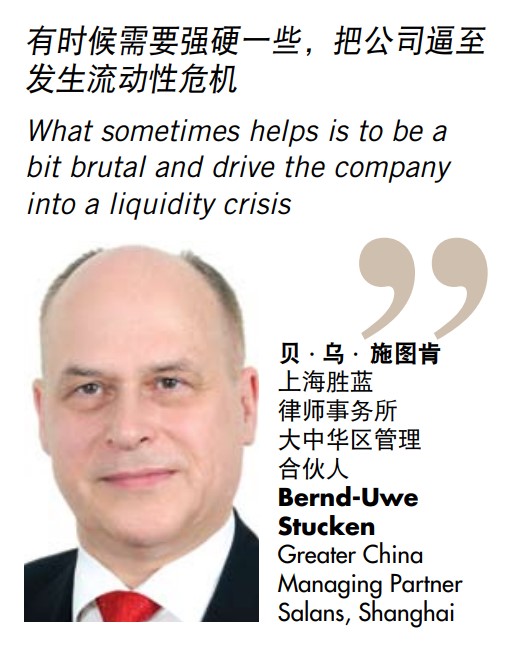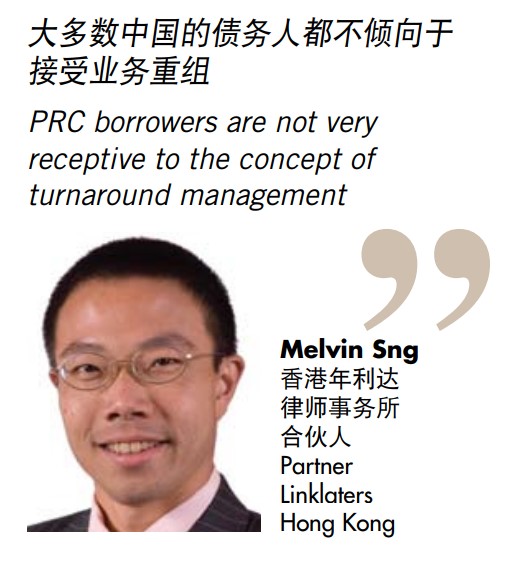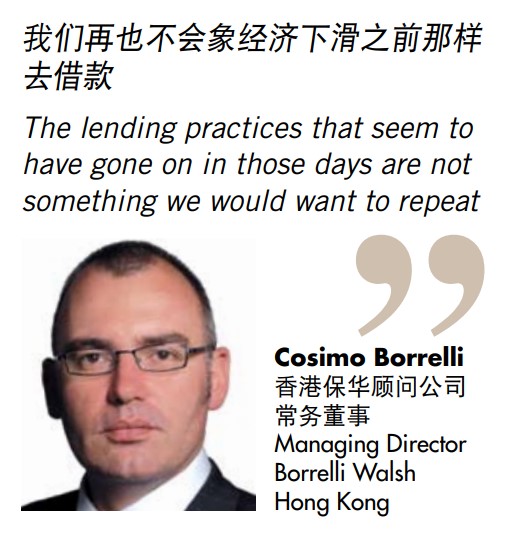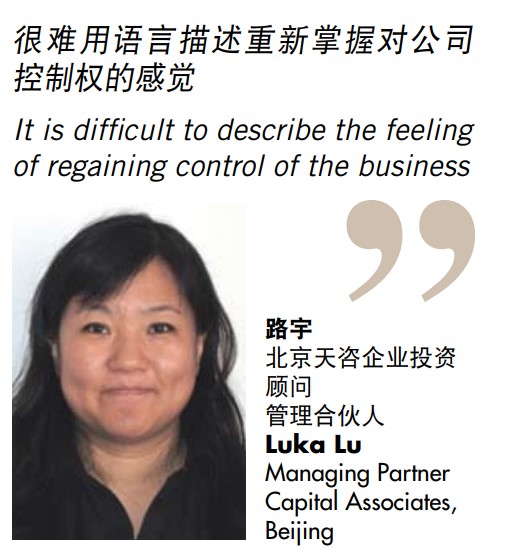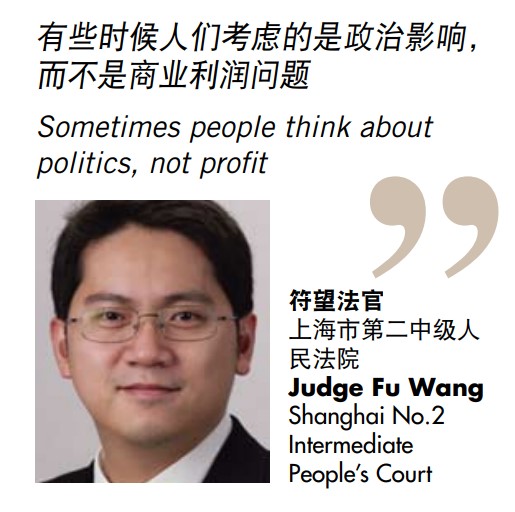The recent economic climate has led to an increase in both operational and debt restructuring. Both can present difficult challenges to companies and consultants, lenders and lawyers. By Robin Weir
Talk to a consultant trying to downsize, reinvent, move or rescue a failing company, and the word “restructuring” will mean operational restructuring, or performance improvement, or (to follow the latest fashion in consultant-speak) “transformation”. Call a partner in a top international law firm, whose clients are investment banks or hedge funds, and the word is more likely to mean debt restructuring. This will typically involve operating assets in China, a holding company or two offshore, and investors who have lent money that the company underneath cannot run fast enough to pay back.
Recent economic troubles have led to an increase in both types of restructuring in China. The impact of both on the companies involved – foreign-invested and domestic alike – can be radical. For foreign companies, and particularly for those which have been operating in China for a long time, the need to restructure can often be linked to their China history. “Investment incentives and local government policies have resulted in most oreign investors establishing new entities for every operation,” says Edward Epstein, managing partner at Troutman Sanders in Shanghai.
The result has been duplication of corporate functions, such as human resources, treasury, procurement and sales, in each entity. According to Epstein, such duplication can be both unwieldy and costly. He believes that many international companies would like to create a group structure in China to consolidate these functions, share resources and reduce the cost of corporate governance. However, he warns that “local protectionism and investment incentive policies make such consolidation of entities and corporate functions difficult if not impossible. Chinese holding companies and regional HQs are an attempt to consolidate, but they can create as many problems as they solve”.
Who buys whom?
The history of a foreign company’s involvement in China, and decisions made early in that company’s involvement in China, has also left many tied to joint venture partners that are less than ideal.
Until the recent economic downturn, says Dr Bernd-Uwe Stucken, greater China managing partner at Salans in Shanghai, the typical result of restructuring a failing Sino-foreign joint venture was the buy-out of the Chinese partner by the foreign partner. A JV would, thus, be turned into a wholly foreign-owned enterprise.
In the new economic climate, however, Stucken has detected a hardening of foreign business’s attitude. “This has changed in the last two or three years in the sense that in most of the situations we have had, our client has wanted to sell and leave China,” he says.
As an international law firm most often representing the foreign side in failure situations, Salans has found itself looking for ways to persuade – or even force – the Chinese party to accept that drastic action is needed. “What sometimes helps is to be a bit brutal and drive the company into a liquidity crisis,” says Stucken. If the joint venture is already in financial difficulty, this can be as simple as refusing to inject extra cash, which can put the Chinese side under intense pressure to find, or to accept, a solution. “There’s a fear, for instance, of not being able to pay the salaries, which destabilizes the operation and sometimes forces the Chinese party to secure liquidity,” Stucken explains.
Where the foreign company has made up its mind to walk away, there are only two real options: either the Chinese party buys the foreign party’s share, or the enterprise closes down. Stucken describes engineering a liquidity crisis as a “pretty brutal approach”, but one which, apparently, gets results.
This begs a wider question: whether in a joint venture or not, does a situation have to be “brutal” before a Chinese company will opt for restructuring? At least from the perspective of foreign companies and consultants, this often seems to be the case.
“The economic ups and downs of the past couple of years have not given rise to the volume of turnarounds that we expected,” says Adam Salzer, a director of advisory services at PricewaterhouseCoopers in Hong Kong. The first reason Salzer offers for this is that many outside investors, particularly those from Taiwan and Hong Kong, have simply walked away when they have experienced difficulties, sometimes leaving their local management to pick up the pieces. “China is still developing its methodology to deal with those situations,” he says.
Salzer’s second reason is perhaps more fundamental. “Local companies tend to avoid the bankruptcy procedure. But they also avoid turnaround. They basically don’t understand that that’s available.”
Why should this be? According to both PwC and KPMG, one reason may be the anxiousness of the government to protect as much employment as possible.
Defensive employment and easy money
Chinese companies that have encountered difficulties in the recent past have had access to cheap and easy bank finance as part of the central government’s stimulus package. A priority for the stimulus has been to maintain and protect jobs. “We have worked with some clients who said ‘unfortunately we have to downsize’ and the banks have said ‘how can we help you avoid that?’,” Salzer observes.
But while the short-term goals of the stimulus package seem to have been achieved, what happens next is unclear. Chinese companies that have used the easy money to keep going through the bad times, but have failed to drive down costs or improve productivity, have surely only delayed the day of reckoning.
A report by KPMG entitled Cash Matters – Cash and working capital management in China, published in March, confirms that the “abundance of liquidity” appears to have caused working capital levels to rise substantially. This has, says the report, “led to less of a focus on active cash management and is contrary to what is being seen elsewhere, i.e. a tighter management of cash and working capital”.
Edward Middleton, head of restructuring at KPMG in Hong Kong, backs up the findings of the report. “Because it has been so easy to get funding from banks, it has been too easy for corporates to fund their working capital requirements. People are just borrowing short-term funds from banks,” he says.
This means that once the flow of funds from the banks dries up – which is already happening now – some companies will be in for a shock. So too their staff, who may in the end face the very prospect of downsizing that the government has been so keen to avoid.
Four thorny problems
Restructuring a company, or a group of companies, in China throws up some thorny issues. Here, lawyers share their thoughts with China Business Law Journal on four of the thorniest: amending a company’s articles of association, changing a company’s legal representative, protecting the company chop, and entering (or avoiding) insolvency under the PRC Enterprise Insolvency Law.
Amending articles of association
According to Edward Epstein, managing partner at Troutman Sanders in Shanghai, the restructuring of a foreign enterprise typically results in the amendment of that enterprise’s articles of association. Epstein offers the following guidance:
Amendment of the articles of association of a wholly foreign-owned enterprise or a joint venture must be approved by the Ministry of Commerce (MOFCOM) branch where the company was incorporated. After the amended articles are approved, the company must register them with the relevant branch of the State Administration for Industry and Commerce (SAIC), and obtain a new business licence. Once that licence is issued, the company may need to complete various post-approval registration formalities, such as tax registration, foreign exchange registration and customs registration.
Epstein believes that this kind of registration is unlikely to prove problematic, as long as the documents submitted are in compliance with the requirements of the local MOFCOM and SAIC branches. He observes that “MOFCOM and SAIC branches in major cities such as Beijing and Shanghai are generally experienced and efficient in handling filings related to corporate restructuring. However, MOFCOM and SAIC branches in other places in China may not be experienced in this kind of filing, so the filings may take longer in these places”.
Changing legal representative
Luka Lu, the managing partner of Capital Associates in Beijing, battled to change the legal representative of a foreign enterprise in western China without the business licence or company chop (see page 29). These items, which are needed to fulfil procedures required by the local administration of industry and commerce, had been removed by management that was angry and resentful. An isolated incident? It seems not.
Cosimo Borrelli, managing director of the restructuring, insolvency and forensic accounting firm Borrelli Walsh in Hong Kong, points to high-profile recent bondholder-driven restructurings in China – Asia Aluminum, China Sun and Hunan Taizinai Group. (Among other things, Borrelli Walsh was the court-appointed liquidator for Taizinai.)
According to Borrelli, when acting for bondholders in such situations, effecting a change to the legal representative is often one of the key battlegrounds. Here, his experiences echo those of Lu. “If you are able to change the legal representative, you are more likely to have some sort of compromise or settlement,” says Borrelli. Technically, changing the legal representative should be a simple matter of passing a shareholder resolution. However, in practice, it may not be that simple. The legal representative is often the founder of the business, who may take an obstructive position. For example, in Taizinai, Borrelli says that the “knee-jerk reaction” of the founder and legal representative was to “sue the banks for making him borrow money he didn’t need and hand over security he didn’t need to hand over”.
The company chop
Changing a legal representative, or other directors, can revolve around possession of the company chop. According to both Borrelli and Lu, a key goal is to obtain a new business licence with the name of the new legal representative on it from the local Administration for Industry and Commerce. It may then be necessary to make new chops, and advertise the fact that the old chops are no longer valid.
But even before this, possession of the chop can be a problem. Betty Yap, a partner at Linklaters in Hong Kong who often acts for lenders in debt restructurings, elaborates. “If you don’t have the company chop to begin with, you can’t seal the forms to submit to the SAIC to change directors. It can take a long time to demonstrate that you, as a security holder, have the ability, even though you are not a shareholders, to remove directors.”
Bankruptcy
Is insolvency within China now a real option? The PRC Enterprise Insolvency Law was promulgated in 2006, after many years of legal and official deliberation. In reality, it has been little used, as companies of all descriptions in China seem instinctively to avoid it.
Judge Fu Wang is a member of the insolvency panel in Shanghai No. 2 Intermediate People’s Court. Since 2006, he has been a member of the team tasked with drafting judicial explanations relating to the PRC Enterprise Insolvency Law. In 2006, the team produced a judicial explanation regulating the appointment and remuneration of insolvency administrators. Since 2008, the team has been preparing a comprehensive judicial explanation relating to the PRC Enterprise Insolvency Law.
Judge Fu points to the linguistic distinction in Chinese between chongzu, or reorganization which is not a legal procedure, and chongzheng, an insolvency procedure carried out under court supervision. He says that chongzu is used more frequently than chongzheng, pointing out that all 20 courts in Shanghai together only deal with around 70 insolvency cases a year. “Sometimes people think about politics, not profit, so when we enforce the insolvency law we have a lot of difficulties. That’s why the court is reluctant to take these cases”.
Nonetheless, according to Joe Tam, a partner at Mayer Brown JSM in Hong Kong, courts have been increasingly busy with insolvency cases since 2008. “They have separate divisions to deal with insolvency cases and one point that clients are looking for in their lawyers is the ability to communicate well with the court, because insolvency cases in China are very court dominated. They make judgments on what is good for the company, for the creditors and also what is good for society.”
Judge Fu is also cautiously optimistic. “I still have confidence in our insolvency law. Our supreme court is trying to issue a lot of judicial interpretations or judicial policies to encourage or even force the law courts to take these bankruptcy cases. They have realized that it is very important for our market economy,” he told China Business Law Journal.
Downsizing, harmoniously
Salzer at PwC offers a process he calls “harmonious downsizing”, which has been developed for situations where major cuts are required in staff numbers. Consultants first identify the people that will be asked to leave. The chosen ones are not dismissed, but are “moved off post”, and put through a retraining process to equip them with a variety of skills that have been pre-agreed with the relevant local authorities. This is coupled with an incentive programme under which a bonus is paid in addition to redundancy pay if they succeed in finding new employment. The bonus is front-loaded and decreases over time, to encourage employees to find new positions as quickly as possible. And the approach seems to work. “We have never had a riot, and we have never had a strike,” says Salzer.
There have been other creative ways to avoid redundancies, too. Lesli Ligorner, a partner at Paul Hastings in Shanghai, has been involved in temporary shutdowns of entire production lines, and reductions in hours worked. “It was almost the equivalent of putting people on furlough at a reduced salary,” she says, “but people kept their jobs”. Other solutions she describes include across-the-board pay cuts and the suspension of bonus plans and other benefits, in cases where companies could not afford to pay their entire staff at full rates.
As with PwC’s “harmonious downsizing”, it seems that an intelligent and sensitive approach can often achieve the cost savings a troubled company needs, but avoid the unrest (or worse) which is an obvious risk in such situations. Ligorner says she was “shocked at the speed with which well prepared companies were able to achieve their goals of cutting costs”. Of course, employees must have been happy to be keeping their jobs, albeit with reduced compensation. “I’m sure they weren’t happy to know their salaries were being cut, but they weren’t being laid off.”
Approval, please
For a redundancy programme or a wider restructuring to work successfully, preparation, consultation and communication are themes that lawyers and consultants emphasize repeatedly. Michael Hickman, a senior counsel at Simmons & Simmons in Shanghai, notes that labour regulation and practice “vary significantly from location to location,” and that advanced planning and consultation with all of the parties involved are crucial.
According to Rebecca Silli, a partner at Gide Loyrette Nouel in Hong Kong, a restructuring will require registration and approval from various authorities at municipal, provincial and/or national level. Part of the role of lawyers, she says, is to “consult and verify with the relevant authorities the interpretation and implementation of the regulations applicable to the case in hand”, then to prepare the required documentation “in line with PRC laws but also the China (and local) market practice”.
But who are the relevant authorities, and who must be communicated with? Looming large in most situations are the Ministry of Commerce (MOFCOM), the State Administration for Industry and Commerce (SAIC), the Ministry of Human Resources and Social Security, the local bureaus of these ministries, and any number of different officials and departments of the local or provincial government concerned.
Faced with such a large number of authorities that might decide to obstruct a restructuring, Stucken advocates carrying out a stakeholder analysis to try to ascertain “who could actually be instrumental in solving the problem and who would be against us”. Typically, he says, the original approval authority that was involved in the setting up of the company should be approached. But, he says, it is often useful to try to enlist the support of the local party secretary, the mayor, or even (although they are “difficult to approach”) the provincial governor. “Political involvement is very often a step we will take. It doesn’t always result in immediate reaction by politicians because they may have their own agenda, but sometimes it does.” Interestingly, Stucken reports greater success using this tactic in northern, rather than southern, China. But “once you alarm the authorities they look and listen and they might have a certain influence on the Chinese partner”.
The importance of the chop
Luka Lu, the managing partner of Capital Associates in Beijing, describes a recent case which demonstrates that while gaining the right approvals is of course necessary, simply complying with the law is unlikely to bring a quick and favourable result.
The case involved two wholly foreign-owned enterprises (WFOEs) owned by an offshore investment fund. The companies operated in a remote part of China in a “sensitive” sector involving a lot of government liaison. A restructuring was proposed in which a state-owned company would take a stake in the WFOEs, and which would require the management of the WFOEs to sell part of their small shareholding in the offshore holding company. They disagreed, and threatened to resign.
When the majority shareholder attempted to replace the management team, the chairman and CEO of the WFOEs ran off with all of the company documents, including the business licences and, crucially, the company chops.
This left the majority shareholder in a sticky situation. While it was legally entitled to change the legal representative of the companies, to do so it would have to present the originals of the company documents, including the business licences and chops, to the local Administration for Industry and Commerce (AIC). “While as a matter of law, the shareholders appoint the legal representative and may replace the legal representative at any time, in reality the AIC has turned it into a procedural matter,” says Lu. The documents the AIC needed were, of course, in the hands of the management who were being axed, were angry, and were not cooperating.
Lu and her team decided on a two-pronged strategy, instigating a lawsuit to force the outgoing management to return the company documents, chops and other property, while approaching the local AIC, citing a previous similar case in Beijing in which a particular AIC had been persuaded to issue a new business licence. “Although the Chinese legal system is not based on precedent, previous cases can be used as a reference – in this case to persuade the local AIC to look for a solution,” she says.
Ultimately the situation was resolved by the co-ordinated lobbying of central, provincial and municipal governments. The final step, with the support of the local county governor, a judge and the police, was to take back the site and premises. “The judge called a meeting of all the employees and explained the situation, which was a great source of support for us to regain control of the business,” Lu concludes.
Debt and operational restructuring linked
Lu’s case illustrates the interplay between offshore holding structures and operating assets “onshore” in China, and some of the difficulties that these structures can create. Such difficulties are a defining feature of debt restructuring, which is the other side of the restructuring story.
At first glance, debt restructuring can seem unrelated to the operational restructuring that this article has dealt with so far. Debt restructuring, as undertaken by the corporate teams of international law firms, typically involves a pre-IPO financing structure for which, perhaps due to the economic situation of the past couple of years, the expected IPO has not occurred. Such a structure usually includes one or more offshore companies which own companies or assets in China. Financial institutions have, typically, lent money to the offshore company or companies, in anticipation of an IPO within three or four years. The investment terms usually include an exit date, or “put date”, so that if an IPO has not occurred by a certain date, the lenders can claim repayment of their debt.

In such a situation, lenders are faced with two options: to restructure the debt, or to enforce their security under the finance documentation. The first option means accepting an extended repayment schedule, or perhaps a “haircut” – a reduction of the principal amount. The second option can land the lender in a similar position to a company attempting operational restructuring – dealing with MOFCOM and the SAIC, trying to replace directors, closing or rationalizing operations, trying to gain control of the company chop.
One key issue is simply where the security was taken. Lenders to an offshore holding company are likely to have taken offshore, but not onshore, security. Helena Huang, a partner at Kirkland & Ellis in Hong Kong, notes that the interests of bondholders who have lent to an offshore holding company are “ranked behind the onshore creditors”.
Whether offshore or on, enforcing security can be a lengthy process, and an investor has no guarantee of how much it will end up getting back. “There are so many practical difficulties that it can take a long time, which partly defeats the purpose of security enforcement,” comments Yap. “Most investors are not really interested in enforcement because of what they are likely to get out of it, relative to the possibility of an IPO in the near term. They would rather wait.”
Edward Tillinghast, head of Sheppard Mullin’s international insolvency practice in New York, is currently restructuring and liquidating assets in a series of toll road projects in China, on behalf of what he describes as an “ad hoc” committee of noteholders who invested in a note issue of US$119 million. His comments reinforce the message that the enforcement of security, and the liquidation of assets, in China is not for the faint-hearted. “The biggest challenge is the lack of any predictability and transparency in the courts in certain provinces,” he says. “The Chinese courts have issued decisions that do not appear to be grounded in fact or law, and may have been influenced by locally influential people. They are also extremely slow in issuing decisions, and there appears to be a clear bias against foreign investors,” he continues. “The legal process is very nontransparent and there are few real rules.”
Restructuring deals
Martin Hu & Partners is involved in a corporate restructuring project for a New York-listed North American company, involving two joint ventures and two wholly foreign-owned enterprises scattered across various locations. According to partner Martin Hu, in addition to “uncertain” tax treatment, the need to get local government approval for the liquidation of non-surviving companies and the reduction of the workforce, “the unique challenge in this restructuring is the buy-out of the state-owned Chinese partner”.
Concord & Partners is advising a multinational company on its acquisition of a Chinese delivery company, and on post-acquisition restructuring. According to partner Zhang Yichi, the client’s goal is to integrate the acquired business into its existing operations in China. This will involve the establishment of 27 subsidiaries and 190 divisions nationwide. The assets, business and employees of the target will then be transferred to the newly established entities “on a provincial or regional basis,” which is expected to take between 12 and 18 months.
Troutman Sanders advised a US-based multinational company on restructuring its China operations. The client had over 20 joint ventures and wholly foreign-owned enterprises in China, which were owned by various offshore entities. According to managing partner Edward Epstein, “the objective of that restructuring was to move the ownership of all of these WFOEs and JVs to one single holding company to be established by the client outside China”.
Tian Yuan Law Firm advised dairy products company Beijing Sanyuan Food Company on its acquisition of assets from Shijiazhuang Sanlu Group. Sanlu was one of the companies at the centre of the melamine milk scare which blew up in 2008. After the scare, it was adjudged bankrupt by a court. Sanyuan planned to purchase some of the assets of the bankrupt Sanlu at auction, and planned a private placement to fund the purchase. However it would have been unable to gain approval from the China Securities Regulatory Commission for this in time for the auction. According to Zhu Xiaohui, a partner at Tian Yuan, the firm, together with other advisers, “creatively” designed a plan which allowed the acquisition to take place. Afterwards, Sanyuan’s listed entity established a special purpose subsidiary to manage the former Sanlu assets.
Lan Tai Law Firm advised Huawen Investment Holding Company (Huawen) on the reorganization of its non-financial subsidiaries. PICC Investment Holding Company (PICC Investment) is an investment company wholly-owned by the People’s Insurance Company (Group) of China (PICC Group), and is the controlling shareholder of Huawen. According to Shi Xin, a lawyer at Lan Tai, in the course of the restructuring, the firm dealt with the appraisal of state-owned assets, the successful exchange of equity at the China Beijing Equity Exchange Group (both Huawen and PICC Group are state-controlled companies), and assisting Huawen in making loans of stock rights pledges on the basis of the equities of its subsidiaries. However, as the purchase of the equities of Huawen by PICC Group was not approved in advance by the China Insurance Regulatory Commission, the commission decided to issue an administrative penalty and order Huawen to terminate the injection of funds. Shi Xin indicated that lawyers were waiting for further developments in the case.
Turnaround concept still new
But if an investor is prepared to restructure its debt rather than enforce its security, should it not also consider restructuring the underlying operations, to improve their performance and make a successful exit more likely in the long term? Here, it seems, advocates of operational turnaround are swimming against the tide.
According to Cosimo Borrelli, managing director of specialist restructuring, insolvency and forensic accounting firm Borrelli Walsh in Hong Kong, few of the companies which were on track for an IPO, and borrowed accordingly, have a business model that is able to survive in the changed economic circumstances since late 2008. “Most of them needed the IPO for the bondholders to be made whole,” he states. “With the benefit of hindsight, there are generally half a dozen reasons for that, but they all typically fall into the category of it wasn’t a sound business idea in the first place.”
Problems with the underlying business, Borrelli continues, range from exaggerating the value of the business at the beginning, to misuse of money subsequently borrowed. Or it may simply be that the business has not met its financial targets because of the downturn. Viewed in the cold light of post-recession day, perhaps some of the original lending decisions were misguided. “Frankly, the lending practices that seem to have gone on in those days are not something we would want to repeat,” he says.
Huang believes that many of the investors now grappling with restructuring were too optimistic at the outset, and “probably didn’t negotiate covenants and other legal protections that they would have negotiated in the documents if they had anticipated a downturn”. Their resulting lack of legal rights, she concludes, is one of the reasons why operational restructuring of the underlying business is often not a feasible option. “Because they don’t have those legal rights, it is less likely that they will try to get involved in an actual turnaround, [such as] sending in somebody to the Chinese factory to try to put their own management in place or influence operations”.
Yap’s colleague Melvin Sng at Linklaters comments that their team rarely gets asked about the operational turnaround side of things. “In many instances, with the odd exception, PRC borrowers are not very receptive to the concept of turnaround management that companies in the UK and US have grown familiar with.”
For all of these reasons – and in the face of a widespread lack of appreciation that the turnaround process can breathe new life into a failing company – the operational turnaround skill set is still quite rare in China. But it is beginning to emerge, and not just among foreigners. Salzer at PwC identifies a couple of ‘types’ of Chinese people who are becoming turnaround specialists. The first type comprises those who have been senior managers in organizations in distress which they have succeeded in turning around. “They are the old guard who have managed very large organizations through difficult times. They are very tough and they tend to be older. They gain a reputation that takes them from one project to the next one to the next one,” he says. The second type is of people who emerge from academia. “They quite often come through as professors and move into design institutes or think tanks alongside, then out of those think tanks they are taken into organizations to run alongside management,” he continues, and also notes that there are some individuals in the State-owned Assets Supervision and Administration Commission who have begun to develop a turnaround skill set.
At PwC, Salzer has started a ‘turnaround community’ which meets regularly for dinners and discussions in Beijing, Shanghai, Hong Kong and Singapore. Currently, attendees are limited to senior professionals who have led three or more turnarounds, or have engaged professionals to conduct three or more turnarounds. As lenders and managers wake up to the potential of turnaround, the number of people qualified to attend is surely set to increase. The work seems, at least, to offer job satisfaction. “It is difficult to describe the feeling of regaining control of the business,” says Luka Lu of her recent battle in western China. “One member of the company’s staff described it as ‘a miracle coming true’, after witnessing the dramatic development of the events”.






